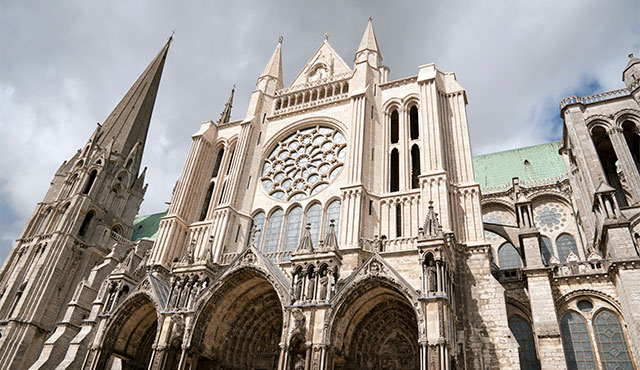To a peasant working the fields outside the village of Chartres, France, his evening call to vespers signals more than the end of his work day. Stepping reverently through the massive doors, his eyes, face and his very soul moves immediately upward. Impossibly high pointed stone arches, separated by massive stained glass windows, filter the harsh afternoon sunlight into a glow that feels soft, yet strong, like the caress of a loving and omnificent God.
The Notre Dame de Chartres Cathedral, like others of the medieval period, was the center of community life. Set amid a simple village of thatched homes, shops and farms, the immense carved structure soars nearly 30 stories high. The effect is explicit and deliberate: to take the mundane and elevate one’s focus to the eternal. Most people could neither read nor write, but through the architecture, the acoustics and the artwork, they experienced the perfect symmetry of God’s creation, understood the holy Trinity, and learned biblical truths from the darkness of sin to the light of salvation. The sheer height of the building along with the stone and glass lifted sounds to an intensity impossible elsewhere. The experience enabled one to see, feel and hear the voice of God, as he might have seemed to Moses atop Mount Sinai.
To a peasant community, their cathedral was the medieval version of a stairway to heaven. It was more than a house of worship; it elevated the soul and senses. For the Roman Catholic Church it was a “teachable moment.” More than 250 years before the printing press, the cathedral was the Church’s textbook for an illiterate population. For the villagers, it was at once a source civic pride, and the engine that drove the economy.
For USC Professor of Architecture Mina Chow, visiting Chartres Cathedral inspired her to pursue architecture. “At Chartres, I was in the presence of something much bigger than me,” she says. “As I walked within the light and shadow, I was awed by the immensity [and felt] that I wasn’t alone. The architecture of cathedrals connects people to the universe and God. The contrast is as darkness to divine light; or as the sacred is to sin. Being in the presence of both is what creates the beauty of architecture.”
For nearly a thousand years, Chartres has affected hearts and souls. The main structure was built from 1194 to 1250. At the time, it was as futuristic as the Burj Khalifa in Dubai or the new London Bridge Tower today.
Construction was financed through the collection plate, and occasionally patronage from the local nobility. Often relics were put “on tour” as a lucrative fundraising mechanism. In an interesting twist, the congregation also raised funds by fining clerics for such transgressions as tardiness.
According to Chow, “Building the cathedral gave purpose and meaning to the lives of everyone in the community, especially the laborers. It was a chance to be a part of something bigger than themselves.” In a time when a third of all children died before age of five, fifteen percent of women died in childbirth and life expectancy was less than 45 years, the construction of cathedrals put one’s life and labors into a much larger context. Laborers, from engineers to stonemasons, carpenters, artisans and construction workers were well paid. This gave rise to a growing bourgeois class and arguably was one of the factors in the late Middle Ages that lifted many peasants out of servitude.
Gothic style, which included architectural innovations such as the pointed arch, flying buttress and ribbed vault, was originally called “Opus Francisenum” or “French Work.” The term Gothic was an Italian Renaissance pejorative to discredit the style, dismissing it as being from the barbarous Goths.
Chartres Cathedral, some 90 miles southwest of Paris, has avoided much of the turmoil of the past thousand years, and would be entirely familiar to the local peasants of the 13th century. Among Chartres’ most distinctive features, the “rose windows” still filter the sun through their original glass. The southern window tells the story of Jesus’ life while the north is dedicated to the Virgin Mary and the west to judgment, with Christ at the center.
Artistically, mathematically and spiritually significant, the rose windows of Chartres transfixed Professor Chow as a young student—so much so that she nearly missed her tour bus until her chaperones found her and dragged her back to the group. Her experience recalls another student engrossed in a temple, only to be dragged home by worried parents who had spent three days searching for him. This is how the Church taught in the middle ages, and Chartres is still teaching today, by lifting the soul to experience the divine.

